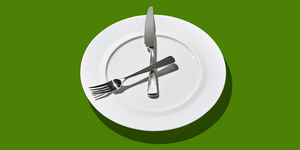People do intermittent fasting—not eating for set periods of time—for many reasons. Some say they do it because they’re aiming for better focus, others are pushing to better their health by reducing inflammation or improving lipid levels. Yet others do it because celebrities like Terry Crews, A-Rod, Hugh Jackman and Chris Hemsworth do it. But probably the biggest reason people turn to intermittent fasting is because they’re looking to lose weight.
The practice doesn’t guarantee you’ll drop pounds, but many people do, largely because restricting eating to certain windows of time also tends to reduce the calories people eat.
As a refresher, there are different ways to fast, but people generally follow three common schedules: alternate-day fasting, whole-day fasting, or time-restricted fasting. Melanie Boehmer, R.D. at Lenox Hill Hospital, recommends starting with time-restricted fasting. One popular way to do this is eating only during an 8-hour window, a format known as the 16:8 format (16 hours of fasting, 8 hours available for eating).
Sometimes you’re doing an intermittent fasting plan to lose weight and the scale’s just not moving. If this sounds like you, it’s a good time to analyze your strategy. These common reasons may explain why you’re not losing weight on intermittent fasting.
You’re eating too many calories
Restricting the time you get to eat doesn’t always cut back calories as much as you might think, if you over-consume during your eating window.

What’s over-consuming? Do a reality check on how many calories your body needs to maintain its current weight. This can be done using a formula or the body weight planner by the National Institute of Health.
Track everything you eat in a given week using FitDay.com, Lose It!, or MyFitnessPal, and see if you’re eating more calories than your body needs, even though you’re restricting the timing of those calories. If you are, you know what to do.
You underestimate portions
If you’re not losing weight—despite staying within your calorie needs—then it’s time to look at serving sizes. It’s common to miscalculate how much you’re actually eating. This is particularly true with calorie-dense foods such as cheese.
For example, a one-ounce serving of full fat cheese equals about four cubes of dice. Use a food scale—or eyeball portions with this tutorial—to more accurately calculate food intake. And keep in mind that you don’t have to eat skimpy looking meals. Beef up a sandwich with crispy lettuce and a bunch of tomatoes. Add broccoli to your pasta to fill your bowl and look satisfying.
You’re not eating enough
If you’ve hit a weight loss plateau after losing a few pounds, says Melanie Boehmer, R.D. of Lenox Hill Hospital in New York City, you may be eating too few calories.
That’s because our bodies adjust to whatever we throw at them, she says.
“If, on average, you’re only taking in 1200 calories, which is something none of us should be doing on a regular basis, your body is going to learn to function on 1200 calories,” she says.
Reduce calories slowly and aim for more moderate weight loss, says Boehmer. She advises cutting enough calories to lose about a pound a week.
“When we talk about losing weight, the goal is always to lose as much weight eating the most that you can so you don’t create that metabolic inhibitor,” she says.
Source: Read Full Article

